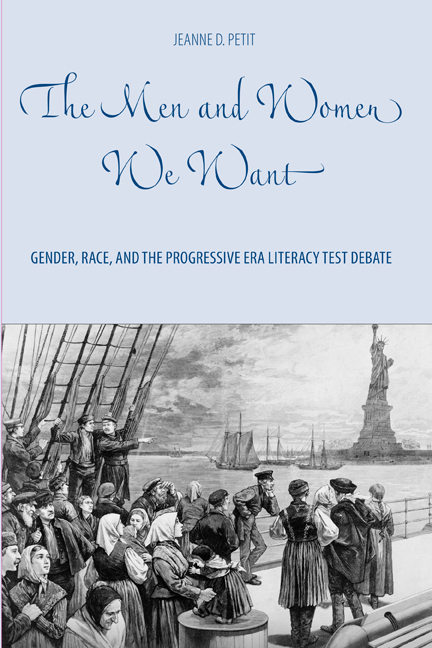Book contents
- Frontmatter
- Dedication
- Contents
- List of Illustrations
- Acknowledgments
- Introduction
- 1 Breeders, Workers, and Mothers: The Beginning of the Literacy Test Debate
- 2 Parents and Progeny: The Dillingham Commission Report
- 3 Muscle, Miscegenation, and Manhood: The Literacy Test at the Height of the Progressive Era
- 4 Practical Aid and Sympathetic Understanding: Grace Abbott's Alternative to the Literacy Test
- 5 World War I and the Literacy Test
- 6 The Legacy of the Progressive Era Literacy Test Debate
- Notes
- Bibliography
- Index
Introduction
Published online by Cambridge University Press: 14 March 2018
- Frontmatter
- Dedication
- Contents
- List of Illustrations
- Acknowledgments
- Introduction
- 1 Breeders, Workers, and Mothers: The Beginning of the Literacy Test Debate
- 2 Parents and Progeny: The Dillingham Commission Report
- 3 Muscle, Miscegenation, and Manhood: The Literacy Test at the Height of the Progressive Era
- 4 Practical Aid and Sympathetic Understanding: Grace Abbott's Alternative to the Literacy Test
- 5 World War I and the Literacy Test
- 6 The Legacy of the Progressive Era Literacy Test Debate
- Notes
- Bibliography
- Index
Summary
Prescott Hall feared for the future of the nation. He observed nearly twenty million immigrants arriving in the nation's ports between 1880 and 1910, more than twice the number that had arrived in the previous hundred years. Unlike the familiar immigrants from England, Scandinavia, Germany, or even Ireland, the vast majority of these “new” immigrants came from southern Italy, Russia, the Austro-Hungarian Empire, and other poverty-stricken and remote countries in southern and eastern Europe. These new immigrants met the technical requirement of “free white persons” set out in the Naturalization Act of 1790, but their racial unfitness, for Prescott Hall, was evident. These people toiled for low wages, lived in wretched conditions, and had children, lots and lots of children, so many children that they threatened to swamp the offspring of the strong, noble Anglo-Saxon race, the race to which Hall believed he belonged. Hall, a Boston Brahmin and Harvard graduate, founded the Immigration Restriction League (IRL) in order to advocate for the restriction of these undesirables. When, in 1909, the Senate Immigration Commission, also known as the Dillingham Commission, asked the IRL to submit a statement, Hall leapt at the chance to push for severe restrictions on immigration.
Hall's solution to the threat of immigration may seem, to modern eyes, curious. Since the 1890s, he and other members of the IRL had proposed that Congress pass legislation requiring adult immigrants to prove they could read and write at least fifty words of English or some other language before entering the United States. In recommending this solution in his statement, Hall said almost nothing about the importance of literacy or an educated citizenry. Instead, he made a racial case in support of the literacy test. Most immigrants to the United States, he warned, “are from races … which have not progressed but have been backward, downtrodden and relatively useless for centuries.”3 He then pointed to statistics about the lower literacy rates among immigrants from southeastern European nations and insisted that a literacy test would be the best means to keep those immigrants out. Hall dismissed arguments that poverty and oppression in southeastern Europe led to higher rates of illiteracy or that the educational opportunities in the United States would uplift immigrants.
- Type
- Chapter
- Information
- The Men and Women We WantGender, Race, and the Progressive Era Literacy Test Debate, pp. 1 - 13Publisher: Boydell & BrewerPrint publication year: 2010

